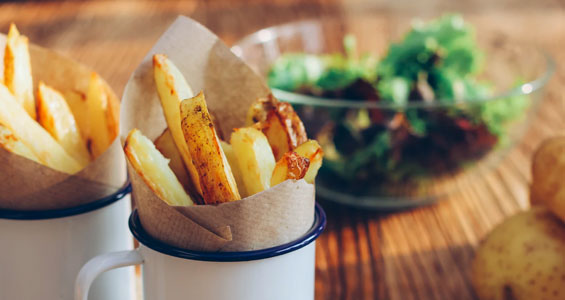
We already knew that French fries — with their fat, calories, salt and dipping sauces — aren’t exactly a health food. Now, there’s more bad news, as reported by Time Magazine last year: “New evidence in animal studies suggests that regularly eating fried, browned or burnt foods — such as French fries — may increase the risk of cancer.”
When starchy foods, in particular, are browned, they release a substance called acrylamide, which has been linked to cancer in animals. For humans, French fries and potato chips are the top food sources of acrylamide. Whether it poses a cancer risk to us remains to be proven but, until then, many agencies urge caution for frequent fryers.
Here are tips and approaches to eating healthier:
Downsize your fries when ordering out
- Order the small size. Those first few, piping-hot fries taste the best anyway.
- Get one order for the whole table (or carload) to share.
- Choose fries less often, as a once-in-a-while treat, not a regular thing.
- Choose thick-cut, skin-on fries when you have a choice — you’ll cut down on oil and boost nutrition.
Make healthier home fries
The American Cancer Society and the Food and Drug Administration offer smart, science-based advice for preparing healthier spuds at home:
- Cook to golden instead of brown. Browned areas are the highest in acrylamide, which tends to increase with higher cooking times and temperatures. Go for the gold with home fries, as well as hash browns, other starchy vegetables and even toast.
- Use the oven instead of the fryer. Roasting creates less acrylamide than frying. Baking whole potatoes is even better. For the healthiest spuds, boiling and microwaving whole potatoes produces zero acrylamide.
- Soak raw potato slices in water for 15 to 30 minutes before roasting or frying (blot dry before cooking). This reduces acrylamide during cooking.
- Don’t store spuds in the fridge — that can increase acrylamide during cooking. Keep them in a cool, dark place, such as a closet or pantry.
Choose better sides
Enjoying a few fries or chips now and then probably won’t hurt you. But choosing healthier sides most of the time will do you and your family a lot of good. We like:
- Roasted green beans, asparagus or Brussels sprouts
- Baked potatoes with skin on (top with fat-free sour cream)
- Oven-roasted kale chips
- Veggie sticks with hummus
Recipe: Crispy baked asparagus “fries”
They’re shaped like fries. You can pick them up and eat them like fries. But fresh asparagus spears — in season now — have much more to offer nutritionally than fries. Asparagus is absolutely loaded with nutrients known to help control blood sugar, fight cancer, boost brain power, reduce inflammation and slow the aging process. What’s more, it’s easy to prepare and utterly delicious. Make asparagus your new “side of fries.”
- 1-1/2 pounds asparagus, trimmed
- 1/2 cup flour
- 2 eggs, lightly beaten
- 3/4 cup panko bread crumbs
- 1/4 cup Parmesan cheese, grated
- Salt and pepper to taste
Dredge asparagus spears in the flour, dip in the egg and then into a mixture of the panko, Parmesan, salt and pepper. Arrange spears in a single layer on a wire rack on a baking sheet. Bake at 425° until golden, about 7-13 minutes.
4 servings: 151 calories, 4.3g fat (1.8g sat fat), 2.2g carbs, 10.8g protein, 4.1g fiber, 100mg sodium, 3.8g sugar
A lighter, simpler option: Ditch the dredging. Just toss asparagus with oil and Italian seasoning and roast for 7 minutes until crisp-tender. Sprinkle with balsamic vinegar, Parmesan, salt and pepper. Just 78 calories per serving.


